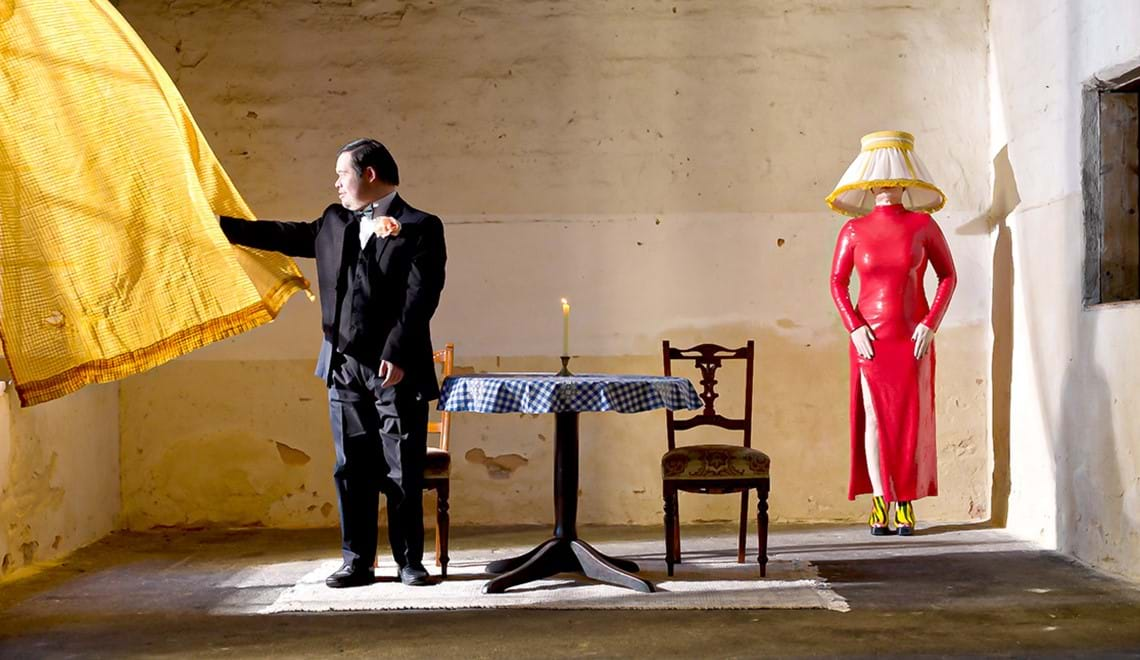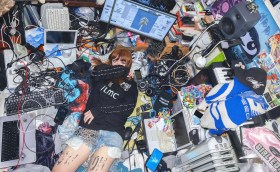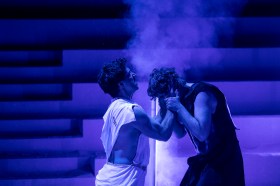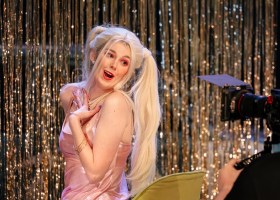The question of voyeurism is unavoidable for any work that features performers with disabilities. The content of Private View by Restless Dance Theatre renders the issue even more pressing because it deals with the performance of sexuality, desire and fantasy, as well as broader notions of longing for intimacy and love.
Dramaturg and creative producer Roz Hervey states in a program note that ‘a range of techniques’ such as basing the work on research interviews and using character names, were employed so that ‘the dancers’ lives are not on show’ (in other words, they’re not playing themselves), but this is a slippery distinction in practice, especially for an audience.
The theme of voyeurism is dealt with more openly by director Michelle Ryan and designer Renate Henschke in terms of how the work is staged. The audience is free to choose either to sit on chairs to one side of the space, or on stools in the centre (I chose a stool). Around us, the action takes place on four raised stages – one “act” at a time, in clockwise rotation – and occasionally spills out among us into the centre of the space.
Our view of the four stages (artfully lit by Matthew Adey) is initially obscured, either by a projection scrim, Venetian blinds, a Perspex wall or translucent curtains, behind which the performers can be dimly seen; but this changes as each “act” begins.
All of this effectively sets the scene for a kind of peepshow, while also rendering the audience (at least, those of us seated on stools in the centre) strangely vulnerable. This sense of audience vulnerability is heightened when things are reversed and a performer’s gaze is trained on us – and, even more so, when “our” space is invaded, either physically or when we’re directly addressed and asked to respond (all of which is handled with great care, gentle humour and audience-friendliness).
To be sure, none of this “absolves” us of voyeurism, but it foregrounds the issue, and to a certain extent turns the tables. It also raises the question of whether and to what extent vulnerability and even a kind of objectification are inherent in all forms of sexuality, voyeuristic or otherwise.
The theme of the gaze is initially established by the pre-set video projection of a pair of eyes – with blinking, peacock blue-sequinned lids – on the scrim in front of one of the raised stages. This image is replaced once the show begins by a pair of lips (painted with heavy red lipstick) singing the first of a series of entrancing songs by chanteuse-composer Carla Lippis – who emerges live during the song in a black velvet catsuit with a Liza Minnelli/Sally Bowles bob and make-up.
She proceeds to guide us musically as well as visually through the rest of the show, while also serving as a kind of cat-like familiar spirit or shadow for the other performers, most of whom have unspecified disabilities.
On the first stage (revealed once the scrim is raised), Michael Hodyl plays a character on an imaginary dinner date, in a sequence that includes some deft dance moves and sly audience interaction.
Madalene Macera and Jianna Georgiou provide one of the most arresting images in the show at the start of the second sequence when their hands and pink-painted fingernails frenziedly penetrate the closed Venetian blinds that surround the second stage.
The blinds open to reveal them cavorting on a bed, flicking through magazines and making calls on pink old-fashioned cradle telephones. Lippis then directs their calls to randomly chosen audience members, who are invited to use her microphone to answer Georgiou’s teasing questions (mine was ‘What does a testicle look like?’).
The third sequence is the most physically, emotionally and visually complex, and involves dancer Bonnie Williams emerging from behind the Perspex wall at the back of the third stage into a kind of open booth to perform an expressive and intimate solo (sensitively choreographed by Larissa McGowan), while Lippis accompanies and shadows her outside the booth.
Another of the show’s most striking images involves the singer’s face peering in through a Perspex side wall while a reflection of the dancer’s body extends below her on the inner surface of the wall, in a haunting visual effect made possible by Henschke’s design and Adey’s lighting.
In the fourth and final sequence, Darcy Carpenter, Charlie Wilkins and guest dancer Rowan Rossi (who’s also a dance teacher with the company) perform a comic trio on and around a modular sofa, with Carpenter and Wilkins flirting – initially via text messages (which appear on a screen overhead) and then more physically – while Rossi tries to police their activities, but ultimately fails to keep them apart.
Read: Theatre review: The Government Inspector, Clubhouse Theatre, Townsville
A closing song from Lippis brings the audience to their feet as lighting transforms the entire space into a communal dance floor, and all distinctions based on ability or disability – or who is watching and who is being watched – finally seem to melt away.
Private View
Restless Dance Theatre
Odeon Theatre
Director: Michelle Ryan
Dramaturg and Creative Producer: Roz Hervey
Assistant Director: Daisy Brown
Singer and Composer: Carla Lippis
Composer: Geoffrey Crowther
Choreographer: Larissa McGowan
Lighting Designer: Matthew Adey
Designer: Renate Henschke
Cinematographer Matt Byrne
Rehearsal Director: Sarah-Jayne Howard
Dancers: Charlie Wilkins, Darcy Carpenter, Jianna Georgiou, Michael Hodyl, Madalene Macera, Bonnie Williams (guest artist), Rowan Rossi (guest artist)
Tickets: $25-$59
Private View will be performed until 9 March 2024 as part of Adelaide Festival






